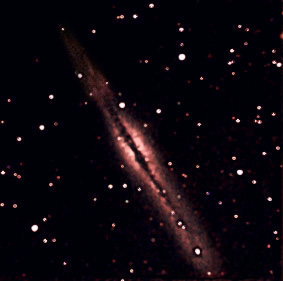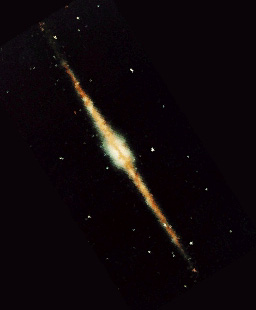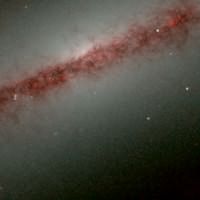
©2006 Richard Murray

Does this galaxy look familiar?
It should.......
This big beautiful galaxy (top image) is one of the rare spirals that presents itself to us edge-on. Notice the dark dust and gas lane which bisects the galaxy thus hiding millions of stars from view.

In recent years astronomers have taken a much closer look at NGC891 because of some very unusual phenomena taking place there. It appears that numerous stars as well as molecular gas clouds are moving at such extreme velocities that they violate the laws of circular motion and, in fact, shouldn't even be able to remain as part of the galaxy itself. In addition, there are a large number of gaseous filaments spreading the length of the galaxy that are perpendicular to the galatic plane and extend well away from the disk. Although there are no clear explanations for what is occurring, one theory attributes the high velocity to the possibility of a huge bar of gaseous material which extends across the entire middle of the galaxy. If we could view NGC891 face on the bar would be very obvious. The gaseous filaments may be caused by a series of stellar supernova explosions which ejected the gas towards the galatic halo (see NASA image of the filaments below). Whatever the cause for these phenomena, NGC891 will be the subject of scientific scrutiny for years to come because its behavior is so complex that more questions are raised than answers.

But there's another reason why scientists are so interested in NGC891. Of all the spiral galaxies we have discovered, this one comes the closest to being a spitting image our of own galaxy, the Milky Way. If we were able to view our Milky Way edge on you would probably be hard pressed to tell the difference between the two galaxies. The second galaxy image shown above just below the top image was taken by NASA's COBE satellite in 1990 at infrared wavelengths. If the image was taken in visible light, you would see a dark bar bisecting the entire length of the galaxy just like NGC891. This is, in fact, an actual image taken of our own Milky Way from Earths location which is 30,000 lights years from our galaxy's center. Infared imaging allows us to penetrate past the obscuring dust clouds so we can image almost to the center of our galaxy.
Techno Stuff: Image at top taken on 12/31/04, LX90, ATK-2HS, 0.6 FR, Baader IR, 5fps, 30 x 45.5 secs,Brightness 45%, Gamma 50%,Sat 50% Gain 80%, White Balance nothing selected, Darks used, Processed in K3ccdTools, Registax, Corel Photo Paint, Photoshop, Selective color added.
4 comments:
Great blog! Thanks for the cool images!
Thank you David! Comments like yours motivate me to do more blogging. :>)
Kewl Pics!
Thank you Squirrleymojo. I like your blogsite too.
Interesting comments about Michael Moore.
Rick
Post a Comment